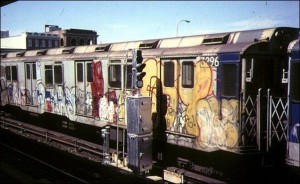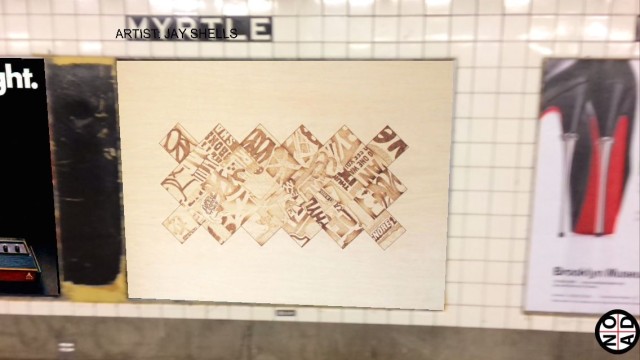Free app swaps New York subway ads for street art
https://www.cultofmac.com/298127/ad-turns-new-york-subway-street-art-wonderland/
Free app swaps New York subway ads for street art

If you’ve ever visited the subway platforms in the Big Apple, you know they’re plastered with advertisements. That’s where a free new app called NO AD comes in.
The work of Re+Public, a team of devs who use technology to “alter the current expectations of urban media,” NO AD is an augmented-reality app that strips the New York City subway system of its ads — and replaces them with art.
Just point your iPhone camera at a billboard and, hey presto, you’ll see it vanish and a piece of street art will seamlessly appear where there was once corporate propaganda.
Pretty neat, huh?
“I’ve always appreciated the street artists who were trying to bring art out of the galleries and to the people,” says NO AD co-creator Jowy Romano. “That’s what we’re trying to do. Most New Yorkers have a love/hate relationship with the subway. We want to change that space in a positive way — even if it’s just through a mobile device.”
Romano, 30, grew up in New York City after graffiti’s heyday. After peaking in the 1970s, graffiti on the New York subway system began to decline — with particularly tough crackdowns taking place in the late ’80s, including the replacement of many subway cars and the so-called Clean Train Movement.

Banned from the subway system, graffiti was forced to go even further underground.
“I was pretty young when the last subway car was cleaned, so I missed when graffiti was at its height,” Romano says. “As far back as I remember, you really had to look for the good graffiti, which is exactly what I was doing when I started my blog.”
Romano’s blog, Subway Art Blog, was dedicated to tracking down the best underground art shows and uncommissioned masterpieces on the subway system.
Through it, he helped create the idea for the augmented-reality app that became NO AD, working with the likes of artist and activist Jordan Seiler.
“The app uses image recognition,” Romano says. “Each week I go into the subway and take multiple pictures of all the ads that are up on the walls to catalog them. The app then analyzes the shapes within the ads and recognizes them so that they can be replaced by our own images, which are created to the same dimension as the original ad.”
Part of the inspiration, he says, was a scene in 1988 cult movie They Live. In the flick, pro wrestler “Rowdy” Roddy Piper plays a construction worker who discovers Earth is ruled by aliens that conceal their appearance in order to rule humankind.
To do this, they keep people as unconscious slaves by manipulating them into breeding, spending money and accepting the established social order. This is done using subliminal messages hidden in adverts.
In one memorable scene, Piper gets hold of a pair of sunglasses that allow him to see the “truth” behind the adverts that surround him: one-word slogans reading “Buy,” “Consume,” “No Thought,” “Conform,” “Stay Asleep” and “No Imagination.”
“It actually really reminded me of the famous dystopian ad for the Macintosh,” Romano says of the scene, referring to Ridley Scott’s famous 1984 ad, which shows a free-thinking dissident freeing IBM-loving drones by way of a well-aimed sledgehammer toss.
“The app itself proposes new ways of seeing,” says co-creator Seiler. “With NO AD, we are revealing new possibilities for how we use our shared public spaces. I hope people not only enjoy the work on exhibit but also realize that the app is a window into a different world where our cities are not clouded by commercial signage and where art and culture take a more prominent role.”
“It really reminded me of the famous dystopian ad for the Macintosh.”
Going forward, there are plenty of exciting opportunities. In addition to varying up the art on display (which Romano says will happen on a monthly or bi-monthly basis), there’s also no reason to keep the app limited to flat images. In place of street art, ads could be replaced by videos or 3-D imagery.
“Looking forward, the biggest idea of all is to use this with a wearable technology, similar to Google Glass,” Romano says. “We definitely think that one day you should be able to walk into the subway with a pair of goggles on. That would take this technology to the level level. In that sense, the current version of NO AD is kind of a proof-of-concept for the future.”
Even in its present iteration, Romano says the response has been great — both from artists keen to get involved, and from users downloading the app.

“It’s been overwhelmingly positive,” he says. “People seem to really respond to the idea, and some are using it in ways that we never expected. For example, street art fans have trying to find all 100 art pieces in the app, much like they hunt for art on the street, and have been posting their findings to social media. That’s a really fun use of NO AD — and one I’d never thought of before.”
The only people who may not like NO AD are, predictably, advertisers — and the companies who work with them to keep ads hitting eyeballs several hundred times a day.
“I don’t think advertisers are our biggest fans exactly,” Romano says. “But the way I see it, what we’re doing isn’t all that different to a browser running ad-block software. At its root, NO AD is all about bringing a choice to people that currently don’t have it. Most of us have to take the subway every day whether we like it or not. As a result, we don’t have a choice about whether or not we see the ads that are up on the wall. Our aim is to give people that choice back. Hopefully we’ve succeeded.”
Comments
Post a Comment